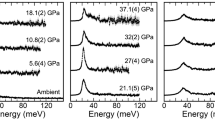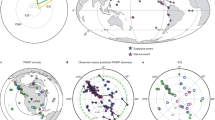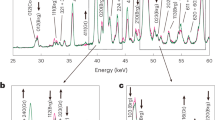Abstract
Adiabatic and chemically homogeneous solid regions of the Earth are expected to appear otherwise because of the bulk attenuation to seismic waves that occurs in polyphase aggregates such as the Earth's mantle. Because the seismologically measured bulk modulus is only partially relaxed compared with the hydrostatic pressure–density relation (or relaxed modulus) of the Earth's mantle, an apparently nonadiabatic contribution1 to the geotherm is expected to be inferred from seismological observations on regions of the mantle that are well mixed by vigorous convection. Using a recent analysis of bulk attenuation in polyphase assemblages2, we estimate the total nonadiabatic contribution to the geotherm through the lower mantle to be approximately −300 to −800 K. The magnitude of this effect is significant in that it is of the same order as the temperature change within a thermal boundary layer, which represents the largest perturbation of the geotherm resulting from convection within the Earth. Moreover, if the lower mantle is truly homogeneous and adiabatic, it should appear to be subadiabatic according to the seismological data.
This is a preview of subscription content, access via your institution
Access options
Subscribe to this journal
Receive 51 print issues and online access
$199.00 per year
only $3.90 per issue
Buy this article
- Purchase on Springer Link
- Instant access to full article PDF
Prices may be subject to local taxes which are calculated during checkout
Similar content being viewed by others
References
Birch, F. J. geophys. Res. 57, 227–286 (1952).
Heinz, D. L., Jeanloz, R. & O'Connell, R. J. J. geophys. Res. 87, 7772–7778 (1982).
Dziewonski, A. M., Hales, A. L. & Lapwood, E. R. Phys. Earth planet. Inter. 10, 12–48 (1975).
Dziewonski, A. M. & Anderson, D. L. Phys. Earth planet. Inter. 25, 297–356 (1981).
Bullen, K. E. The Earth's Density (Chapman & Hall, London, 1975).
Verhoogen, J. Energetics of the Earth (U.S. National Academy of Sciences, Washington DC, 1980).
Jarvis, G. & McKenzie, D. P. J. Fluid Mech. 96, 515–583 (1980).
Jeanloz, R. & Richter, F. M. J. geophys. Res. 84, 5497–5504 (1979).
Shankland, T. J. & Brown, J. M. EOS 61, 1108 (1980).
Brown, J. M. & Shankland, T. J. Geophys. J. R. astr. Soc. 66, 579–596 (1981).
Bullen, K. E. Geophys. J. 7, 584–592 (1963).
Masters, G. Geophys. J. R. astr. Soc. 57, 507–534 (1979).
Thomsen, L. J. geophys. Res. 77, 315–327 (1972).
Kumazawa, M. J. geophys. Res. 74, 5311–5320 (1969).
Budiansky, B. J. Mech. Phys. Solids 13, 223–227 (1965).
Hill, R. J. Mech. Phys. Solids 13, 213–222 (1965).
Budiansky, B. & O'Connell, R. J. Solid Earth Geophysics and Geotechnology, AMD 42 (ed. Nemat Nasser, S.) (American Society of Mechanical Engineering, 1980).
Author information
Authors and Affiliations
Rights and permissions
About this article
Cite this article
Heinz, D., Jeanloz, R. Inhomogeneity parameter of a homogeneous Earth. Nature 301, 138–139 (1983). https://doi.org/10.1038/301138a0
Received:
Accepted:
Issue Date:
DOI: https://doi.org/10.1038/301138a0
Comments
By submitting a comment you agree to abide by our Terms and Community Guidelines. If you find something abusive or that does not comply with our terms or guidelines please flag it as inappropriate.



